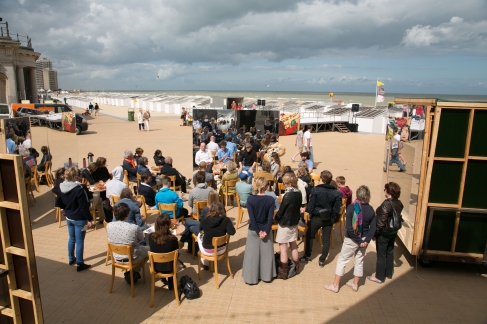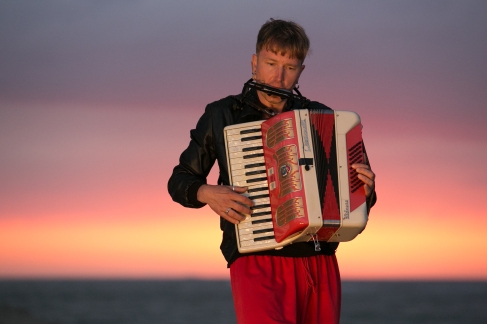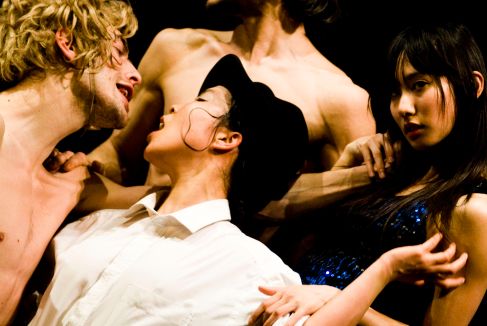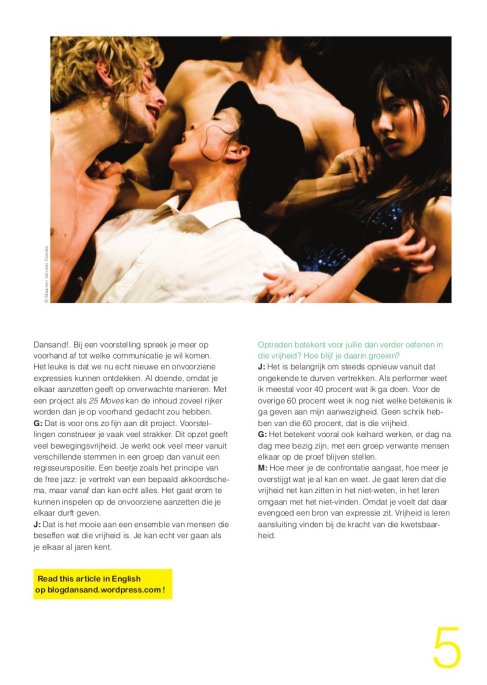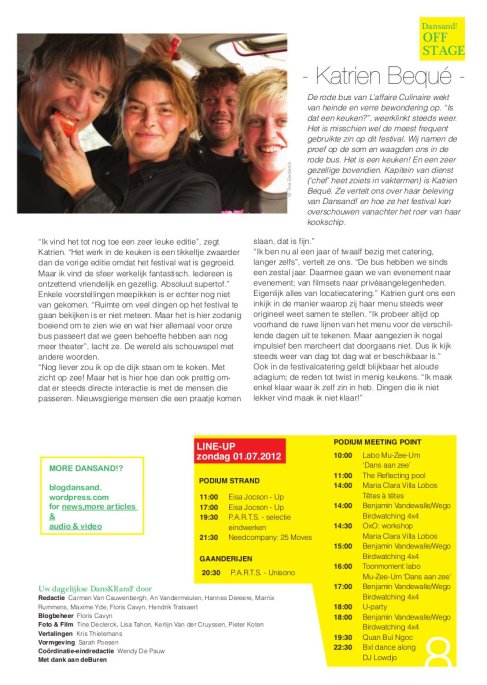Gezien en goedgekeurd? – 25 Moves van Needcompagnie gerecenseerd –
Een gedroomde headliner. Dat was Needcompany’s 25 Moves voor Dansand! De remix van live muziek, dans, kostuum en beeld ter ere van het 25 jaar jonge gezelschap overspoelde zondagavond het strand van Oostende met een wervelende beeldenstroom. Want waar de kleine, vergankelijke mens met alles wat hij heeft de strijd aangaat met de eeuwigheid van de zee, komen waanzin, liefde, exces en schoonheid steevast in elkaars vaarwater terecht.
Het beginbeeld van Needcompany zat meteen juist. Een bonte theatertroep in de verte van het strand, zingend, dansend, onversterkt uit volle borst. Performers die stoutmoedig de zekerheid en het comfort van de zaal durven loslaten om de overweldigende ruimte van het strand in haar volle poëtische kracht te gebruiken. Zo overtuigend was dat op de derde editie van Dansand! nog niet gebeurd. Meg Stuart had het al gedaan, maar zij behield visueel het overwicht met de graafmachines van Jozef Wouters. De meditatieve constellatie van Alexander Baervoets gaf ook een moedige aanzet, maar bleef voorzichtig contemplatief. En bij de First Dates of bij Thirst van David Hernandez werd de setting van het strand overwegend decoratief ingezet en bleef de opvoering dicht bij de tribune. Needcompany vertrekt niet vanuit de zaalcondities die het openlucht podium nog tracht te bieden maar puurt bewegingsvrijheid uit de obstakels van de weidse omgeving.
Dat akoestisch duel met het strand wordt geregeld terug opgezocht. Ook al nadert Needcompany vervolgens de tribune om haar jamsessie versterkt verder te zetten. Geen rockconcert zonder speakers, moeten ze hebben gedacht. En al gauw balanceert de broeierige gitaarmuziek van huiscomponist Maarten Seghers tussen song en soundtrack, op volle kracht. Meteen gebeurt er op het strand méér dan je in één blik kan overschouwen. Je dwaalt af naar de overdadige verschijning van Grace Ellen Barkey als Oosterse godin, terwijl elders een vinnig dansduet plaatsvindt. Ondertussen transformeert een performer tot fabeldier door de helgetinte kostuums van Lot Lemm. De trip waarin je terecht komt opent een fantasiewereld die ontroerend zacht kan zijn en dan weer bijtend scherp. Al vertrekt 25 Moves vanuit het beeldend arsenaal van Needcompany, het optreden is vooral een ode aan de mens en zijn verbeeldingskracht.
Die mengvorm tussen (locatie)theater en jamsessie blijkt een belangrijke sterkhouder van het toonmoment. Ze zorgt voor energieke variatie, waardoor je als toeschouwer dan eens onder de indruk bent van de vinnige dansbewegingen of de hallucinante kostuums, vervolgens door de extreme mental states die leadzangers Maarten Seghers of Joeri Knaeperlinckx durven opzoeken. Tegelijk houdt ze het gebeuren spannend omdat theaterconventies op de helling worden geplaatst en genres zich voortdurend vermengen. Zo wordt de grens tussen performer en personage soms zo inwisselbaar dat omkleden een act op zich wordt. En door het opzet van een jamsessie met bestaande muziek- en dansfrases overstijgt het gezelschap de impasse waar veel makers op Dansand! mee worden geconfronteerd: ofwel inspelen op de omgeving door improvisatie met risico op schetsmatigheid. Ofwel een bestaand stuk inplanten dat de rol van de zee beperkt tot idyllisch achterdoek.
De sprong die Needcompany met hun studiomateriaal durft nemen staat luidkeels in het teken van vrijheid. Jezelf de ruimte durven geven om in te spelen op een totaal andere context, zonder alles van vooraf onder controle te hebben. In die zin viert 25 Moves de zoektocht die Needcompany al 25 jaar voert: het experimenteren met een levenshouding die schoonheid tracht te puren uit pijn, lichtheid uit verlies, kracht uit overmacht. De eigen fysieke en artistieke grenzen durven opzoeken en in vraag stellen, er durven op te stoten, en weten dat uit die kwetsbaarheid een poëtische kracht kan ontstaan. Oefenen in die transformatie van machteloosheid naar kracht. Het is de bedding die Jan Lauwers en Grace Ellen Barkey de voorbije jaren voor hun gezelschap hebben geschapen. Klaar voor de volgende stroomversnelling. Dat blijkt uit het beloftevolle jong talent dat haar plek vindt in Needcompany. Het is wellicht de enige zekerheid waar je echt op kan rekenen: dat alles blijft stromen.
door Marnix Rummens




